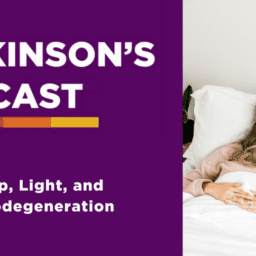Most of the content we create is for people who have already been diagnosed with Parkinson’s. However, we often receive questions from people who don’t have Parkinson’s but worry they might one day.
For example, we recently received a question from someone we believe needed a more thoughtful response than he was given by his doctor. Our reader’s question touches on issues that matter to people who are living with Parkinson’s as well as those who show signs of having REM Sleep Behavior Disorder (RBD).
Here’s the question he sent us:
“I had my first verifiable RBD episode about 30 months ago. The second verifiable episode occurred eight months ago. Since then, the frequency has increased to the point where I am currently having at least one episode a night. I have done the research. I’ve read the peer-reviewed papers and journal articles. I know where we are in terms of a cure for RBD. I also know where this ends, and I am willing to do whatever it takes to be that one in five who lives with fighting the comforter and that’s it. I reached out to the neurologist who has done both of my sleep studies to ask about preventative or early detection measures. He said, “it’s only some people who get Parkinson’s, and it usually takes 13 years; so, we should wait and see if you start to develop symptoms before we do anything.”
(We agree with our reader that this response was not sufficient or helpful in any way.)
And so, I write to you… Anything you can provide that will work towards prevention, or early detection of the nightmare neurodegenerative conditions that come after the RBD will be extremely appreciated. Any information or resources you can provide for ways of coping with this condition would also be absolutely wonderful. Specifically, how does one travel via long plane rides, or long bus rides, or long train rides where you run the risk of attacking another passenger or your surroundings, or at the very minimum shouting obscenities during your travels?”
We’ll address each of our reader’s questions in order.
Is there anything that can be done to prevent the onset of neurodegenerative conditions once you realize you are experiencing a common prodromal symptom?
“Prodromal-PD4 refers to the stage at which individuals do not fulfill diagnostic criteria for PD (i.e., bradykinesia and at least 1 other motor sign) but do exhibit signs and symptoms that indicate a higher than average risk of developing motor symptoms and a diagnosis of PD in the future.“ Practical Neurology
Neurodegeneration, the progressive loss of neurons in the brain and cause of Parkinson’s at a high rate, happens to every one of us. As we age, we naturally lose an estimated 85,000 neurons each day of the 100 billion we have in total. If brain neurons were in a bank account that accrued interest, we’d be okay. Unfortunately, the brain doesn’t deposit neuron paychecks on the first and fifteenth of the month; so, here are some steps that can keep the balance high and counteract neurodegenerative processes.
Environment
First, consider your environment. Air pollution, which we historically associate with heart and lung disease, is increasingly being studied for its adverse effects on brain health. For those near agricultural zones, exposure to pesticides has been linked to higher incidences of Parkinson’s. Despite bans on the use of pesticides with known side effects, trace elements can remain in groundwater and the surrounding environment for decades. If you believe you are experiencing prodromal symptoms, you may want to consider moving to a location with lower instances of these high-level environmental effects.
Exercise
Regular, cardiovascular exercise is a cornerstone of a healthy lifestyle for anyone, whether or not they are at risk for developing NDDs. Exercise causes the release of endorphins, which improves mood and decreases depression. Exercise has also been shown to improve symptoms of NDDs like Parkinson’s by reducing bradykinesia and tremors. Regular exercise also slows the progression of symptoms of Parkinson’s and maintains cerebral blood flow, which can be beneficial in reducing cognitive decline, a hallmark of NDDs. Even more profoundly, several animal and human studies have found that exercise can, in fact, promote neurogenesis, the growth and development of new nervous tissue.
Another hallmark of NDDs, particularly Alzheimer’s, is atrophy of the cerebral cortex. A study involving people with mild cognitive impairment (MCI), a precursor to Alzheimer’s and common in people with Parkinson’s, and control subjects found that by introducing moderate-intensity exercise, cortical thickness increased across the board. Therefore, exercise can counteract cortical atrophy and protect against future cognitive issues.
Nutrition
Diet is more than just fuel for exercise; it can be another important factor in the prevention of NDDs and slowing the progression of symptoms. Oxidative stress can trigger NDDs, but a sensible, low-calorie diet can reduce oxidative stress and introduce neuroprotective factors.
Also, while we still don’t know exactly how it works, caloric restriction can help promote adult neurogenesis in the hippocampus, which again can help slow NDD progression. Omega-3 fatty acids are regularly touted for healthy diets and are found in mackerel, salmon, herring, cod liver oil, oysters, sardines, anchovies, caviar, flaxseeds, walnuts, chia seeds and soybeans. A diet high in these fatty acids can also help improve brain function and reduce depression, which may reduce the onset and effects of NDDs.
Is there anything I can do to slow the progression, frequency or intensity of my sleep disturbances?
Yes, there are several actions you can take.
Sleep
Sleep is increasingly recognized as an actionable component to good health rather than something that “just happens” in between all the other smart lifestyle steps we take like eating a healthy diet and exercising. Establishing a consistent program of sleep is vital for everyone but even more so for those with sleep disturbances associated with neurodegenerative conditions. Sleep hygiene is a term that has come into prominence for a good reason; the development of healthy sleep practice is a considered effort to ensure long-term well-being. Developing the following five consistent, daily habits can improve the long-term quality of your nighttime sleep and reduce the likelihood of disturbances such as RBD.
Set a schedule
Chances are you eat at longstanding established mealtimes because you understand how this influences your ability to live well. Your mind and body will react to consistent sleep in the same way. Regular bedtime and wake-up times, including the weekend, help your body develop a consistent sleep-wake rhythm which has been associated with improved cognitive function.
Be mindful of excessive napping
While daytime naps can be beneficial for recovery from exercise, there can be too much of a good thing. Studies show that excessive daytime napping, intentional or not, can lead to long-term disruption of the circadian rhythm and sleep cycle. Disruption of the sleep cycle has been linked to the progression of dementia and other neurodegenerative conditions.
Avoid alcohol, caffeine and nicotine right before bedtime
Caffeine and nicotine are stimulants and do not promote a restful night’s sleep. Alcohol does have a sedative effect and may help you get to sleep; however, over the course of its metabolization, it will produce several effects that lead to lower quality sleep or awakening and insomnia.
Expose yourself to as much sunlight as possible during the day
Natural light is an important sleep cycle synchronizer, and there is evidence to suggest that circadian system dysfunction may contribute to neurodegenerative states. Where possible, combine time outside in daylight with exercise to optimize the benefit of both.
Consider medication if your doctor recommends it
A common prescription for the treatment of RBD is clonazepam (Kloponin) with reports of effectiveness in 90% of people. Melatonin is an alternative treatment for the remaining 10% of people for whom clonazepam does not work. Dosages of three to 12mg of melatonin have been shown to offer practical sleep assistance and favorable management of RBD behavioral outcomes. As always, be sure to speak with your doctor before trying any medications or supplements.
What are good strategies to employ when traveling if you have RBD?
Anxiety about the occurrence of an RBD episode while sleeping on a long plane, train, or bus ride may keep you from sleeping during travel or prevent you from traveling altogether. There are several actions, though, to safeguard against an RBD episode and reduce anxiety during travel.
Bring a buddy
When possible, travel with a companion who understands what your needs are. Next, try to book travel to take place start-to-finish during your regular waking hours. Fill your time during the journey with engaging activities such as listening to upbeat music, working on puzzles or talking with your seatmate. Don’t let the monotony of a long travel day compel you to nap to pass the time. As mentioned above, long naps can affect your nighttime sleep so be prepared with entertainment or activities that will occupy your travel time. Before you go, check with your travel provider to see what entertainment options are available as well as compatible listening devices you may need.
Give people a heads up
When checking in, speak with gate agents to request a location without other passengers nearby. Once you have your seat assignment, inform staff of any possible issues that may arise and how they can best support you at that time. Flight attendants, for example, are professionally trained to discreetly handle any number of in-flight matters and welcome information in advance of take-off.
Consider a gear upgrade
If you think you’ll doze off during travel and worry about flailing during a dream sequence, use a tucked-in blanket to secure your arms in a safe, restful position. Another possible solution for full-body control is to use a sleep sack. Sleep sacks can be used to limit the movement of your arms and legs during an RBD episode. “Mummy” style liners are tapered even slimmer at the lower legs and feet and offer cinch cords at the opening which can aid in keeping arms inside the sack while asleep. Sleep sacks are handy for all sorts of travel as they are easily packable and can double as a lightweight blanket.
While coming to terms with a diagnosis of RBD isn’t easy, just as it is with a diagnosis of Parkinson’s, research suggests that there are actions you can take to help reduce symptoms and slow its progression.
Want to Learn More about REM Sleep Behavior Disorder?
Check out the following:
What is REM Sleep Behavior Disorder?
Why is it So Hard to Sleep Now that I Have Parkinson’s?
A Primer on Sleep and Parkinson’s
Living Well with REM Sleep Behavior Disorder














A very informative article. Thank you.
I am in the same situation as the letter writer. I have multiple prodromal symptoms including RBD but none of the motor symptoms. I am currently not taking clonazepam because I am concerned about potential side effects. I’ve read that individuals who take clonazepam are at an increased risk for falls as well as developing dementia. I was taking 5 mg. of melatonin but recently increased it to 10 mg. Because I was experiencing more frequent episodes. I recommend taking the time release version. Another suggestion I have is that the writer consider participating in a clinical trial on RBD. Participation my not directly benefit him/her but will hopefully will provide benefits to future generations.
Thank you for reading, Susan. I hope you find a regimen that works for you. Great idea about clinical trials. There are a lot of ways to get involved and live well, despite symptoms. Taking action, as you’re doing, is the best thing you can do.